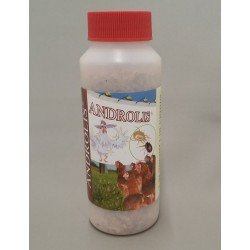Dutchy's 2500 predatory mite - against mites ect.

- Reward Points: 11
- Model: 800004
- Weight: 500.00Gr
Dutchy's 2500 predatory mite - against mites ect.
Dutchy's® are predatory mites from the family Laelapidae and occur freely in nature in large parts of Europe.
They live in the ground and hunt all kinds of soil organisms there. When we release these predatory mites in animal enclosures, they become fierce combatants of, among other things, blood mites.
They chase after them all day and kill them and then eat them. It's only a matter of time; the predatory mites almost always come out as the winner.
2.500 pieces is about 10 caps
 Life cycle of Dutchy's
Life cycle of Dutchy's
Dutchy's® are about 1 mm in size. They have a teardrop-shaped body, are light in color and very mobile.
They feed on all kinds of organisms, such as the larvae of small mosquitoes, springtails and various types of mites, including blood mites.
The eggs are deposited in the ground or in another suitable place.
After a few days, the larvae hatch here, which after a number of molts eventually become adult predatory mites. Dutchy's® eat an average of 5 blood mites per day.
If we deploy them in time, they will often prevent the development of a pest. They are also able to combat significant infestations, but then several predatory mites must be released.
If you have used Dutchy's®, it may be that you will observe more blood mites over a period of a number of days.
This is because the blood mites are driven out of their hiding places by the predatory mites. However, the predatory mites will continue to chase after them, so that this effect disappears after a short period of time.
Dutchy's® are also able to survive a period of food scarcity.
Only then no reproduction takes place. They also eat each other if necessary.
They don't do anything with our animals.
With permanent lack of food, they die out after a few weeks.
An adult predatory mite lives an average of 6 weeks.

Environment of Dutchy's
Dutchy's® preferably live at a temperature of 15 to 25 ºC.
When the temperature falls below or above these values, they pass into a resting phase.
They then wait quietly until the conditions get better and then go hunting again.
When exposed to frost, almost all of them will die.
When the predatory mites are delivered, they are packed with a quantity of humus-rich spreading material.
This material can be ordered in bottles or in Mite Booster cartridges.
There are bottles of 2500 pieces (10 doses), 5000 pieces (20 doses) and 10,000 pieces (40 doses).
The Mite Booster cartridges have a fixed amount of predatory mites.
When you look at the material containing the Dutchy's with a magnifying glass, you will see the predatory mites moving between the grains.
The intention is that the spreading material from the bottles will be placed in small heaps in sheltered places in the animal enclosure.
When the Mite Booster cartridges are ordered, they can be attached to the Mite Booster holder and thus reach the animal enclosure from there.
In the first two weeks, the predatory mites return daily in the spreading material to meet and mate. There are also many eggs and larvae in this material that can all still hatch.
For the exact way of setting and the dosages, we refer you to the specific user manuals.

(PLEASE NOTE THIS PRODUCT ON THE PICTURE IS NOT INCLUDED IN IT!)
This is the Mite Booster system. In the white pattern is the bottom material with the predatory mites.
Dosage of the Dutchy's®
Currently you can choose from two ways of setting out the Dutchy's®: via a bottle and via the Mite Booster®.
When you buy a bottle of predatory mites, you can dose them yourself in different places in the animal enclosure. When you turn off the predatory mites in case of a slight infestation, one bottle cap of spreading material per square meter is sufficient.
If there is a medium-heavy infestation, it is better to put down two, or if it is a serious infestation, three caps per square meter of animal enclosure.
These heaps do not need to be evenly distributed over the entire animal enclosure. Along the side walls is fine, as long as you stick to the aforementioned dosages.
You calculate the number of square meters by adding up the area of the soil and of at least 1 side wall.
Have you calculated the required quantity! Then enter your order via our webshop.
When you use the Mite Booster system, you can order holders and cartridges filled with Dutchy's yourself.
Per infestation and per animal species you can determine the amount you need.
You can read this in the manuals of the Mite Booster.



Use chemicals i.c.m. predatory mites
The use of chemical pesticides shortly before or after the use of Dutchy's® is not recommended. These substances have a detrimental effect on the population development of the predatory mites and can even cause them to die completely as soon as they have come into contact with the remnants of these substances.
It is wise to observe a waiting period of at least 6 weeks after using these substances before deporting Dutchy's®.
When we hang nests in pre-treated bird cages, this is not a problem, as long as the nests are untreated.
It is wise to only release the predatory mites in the nests.













